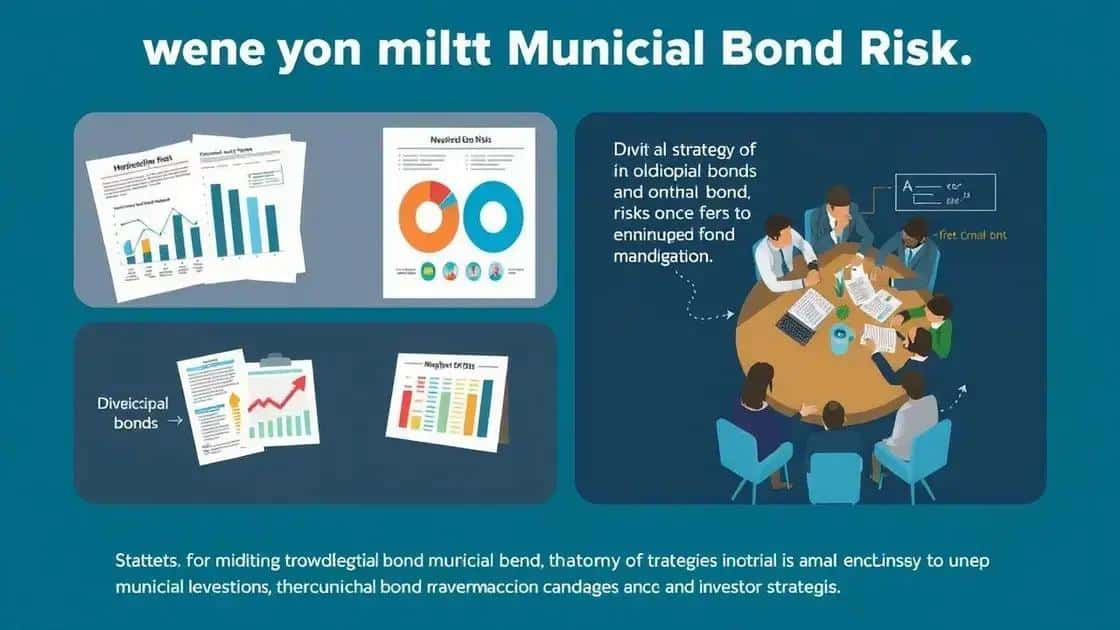Municipal bond default risk analysis: understanding market impacts

Municipal bond default risk analysis involves understanding key factors like economic conditions, issuer credit ratings, and market trends to effectively mitigate investment risks and safeguard returns.
Municipal bond default risk analysis is crucial for investors seeking to navigate the intricate world of local government finance. Have you ever wondered what can impact these bonds? In this article, we’ll explore the essential factors that could shape the future of municipal bonds.
Understanding municipal bonds and their risks
Understanding municipal bonds is essential for any investor looking to navigate the world of local government financing. These bonds play a crucial role in funding public projects like schools and highways, but they also come with certain risks that need to be understood.
Municipal bonds are typically considered safer than corporate bonds, yet they are not without their challenges. Investors should be aware of the risks that could impact their returns and the overall stability of these financial instruments.
Types of Risks Associated with Municipal Bonds
Several factors might lead to default on municipal bonds. Understanding these risks helps in making informed investment decisions.
- Credit Risk: This is the risk associated with the issuer’s ability to repay the bond. If a local government faces financial difficulties, it may default on its obligations.
- Interest Rate Risk: Fluctuations in interest rates can affect bond values. When rates rise, existing bonds may lose value.
- Political Risk: Changes in local government policies or economic conditions can impact the bonds’ viability.
Investors must also consider factors such as market demand and public perception. For instance, if a community experiences a fiscal crisis, the value of its bonds may plummet. On the other hand, strong local economies often enhance the attractiveness of municipal bonds, leading to greater demand.
Why Assess Municipal Bond Risks?
Being aware of these risks enables investors to strategize better. Risk assessment can guide you toward diversification in your investment portfolio. By allocating your funds across different bonds, you can mitigate the impact of any single bond defaulting.
For example, investing in bonds from multiple regions or sectors can cushion against localized fiscal issues. Understanding the landscape of municipal bonds empowers you. It allows you to make choices that align with your investment goals while managing potential risks effectively.
Historical trends in bond defaults

Understanding the historical trends in bond defaults is essential for evaluating the future risks of municipal bonds. Throughout the years, various economic and political factors have influenced these trends. Examining past data can help investors make informed decisions and assess potential risks.
Municipal bond defaults are relatively rare. However, when they do occur, they have had significant impacts on investors and the markets. In the past few decades, notable defaults have highlighted the vulnerabilities in specific regions and sectors.
Key Historical Events
Several key events in history have shaped the landscape of municipal bond defaults.
- The Great Depression: This period saw a spike in defaults as many municipalities struggled with decreased revenue.
- 2008 Financial Crisis: A significant number of defaults occurred as cities faced budget shortfalls due to plummeting tax revenues.
- Recent Fiscal Issues: Some municipalities have faced ongoing financial challenges, leading to isolated instances of defaults.
These events reveal important patterns. For instance, economic downturns often correlate with higher rates of default among municipalities. Additionally, the type of projects funded by bonds can also play a role; essential services tend to fare better than funding for luxury projects.
Analyzing Default Rates
By analyzing historical data, investors can identify trends that might indicate future risks in the municipal bond market. Understanding which sectors have historically faced more defaults can provide crucial insights. For example, bonds issued for infrastructure projects might carry different default rates compared to those for recreational developments.
Trends also reflect shifts in policy and management among municipal issuers. A careful review of these factors helps investors maintain a balanced perspective on the stability of their bond portfolios. Historical context fosters awareness of market cycles, enhancing the investor’s ability to make better choices.
Key factors influencing default risk
Several key factors influence the default risk of municipal bonds. Understanding these factors helps investors gauge the stability of their investments and make informed decisions. Economic conditions, political stability, and financial management are among the primary determinants.
For instance, economic health directly impacts a municipality’s revenue. If a city is thriving, its bonds are likely more secure. Conversely, during economic downturns, tax revenues may decrease, raising the risk of default.
Critical Factors to Consider
When evaluating the risk of municipal bond defaults, keep these critical factors in mind:
- Economic Performance: A city’s job market and income levels play a vital role in determining its ability to repay bonds.
- Tax Base Stability: A stable and broad tax base ensures steady revenue. Areas heavily reliant on sales tax can be more volatile.
- Debt Levels: High levels of existing debt compared to revenue can indicate potential difficulties in servicing additional bond issues.
- Management Quality: Effective leadership and sound financial practices are crucial for maintaining fiscal health and transparency.
In addition to these factors, political stability can significantly affect bond markets. If a local government faces turmoil or frequent changes in leadership, investors may perceive increased risk. Moreover, community sentiment can also influence bond performance. A supportive community can foster strong financial backing for municipal projects.
The Role of Ratings Agencies
Credit rating agencies assign ratings to municipal bonds, reflecting their perceived risk levels. These ratings consider all the aforementioned factors. A higher rating signals lower default risk, while a lower rating suggests greater risk. Understanding how these ratings are determined can further elucidate the dynamics of the bond market.
By keeping an eye on economic indicators and political trends, investors can better anticipate potential default risks and adjust their strategies accordingly. A thorough analysis of these key factors equips investors for smarter decisions in the municipal bond market.
Strategies for mitigating municipal bond risk

Mitigating municipal bond risk is vital for investors who want to protect their investments and optimize returns. Understanding effective strategies can help you make smarter decisions in your bond portfolio. Several approaches can mitigate risks associated with municipal bonds.
Diversification is one of the most effective strategies. By spreading investments across various bonds from different municipalities, sectors, and purposes, you can reduce the impact of a single bond’s default. This way, even if one bond underperforms, others may perform well, balancing the overall risk.
Key Strategies to Consider
Here are several strategies you can implement to minimize risk:
- Research the Issuer: Before investing, thoroughly assess the financial health and credit ratings of the issuing municipality. Understanding their economic conditions helps predict future performance.
- Stay Informed on Market Trends: Regularly follow economic and political developments that might affect municipal finance. Awareness of potential changes enables proactive adjustments to your portfolio.
- Invest in Insured Bonds: Consider bonds that are insured against default. This insurance can provide an extra layer of security for your investments.
- Utilize Bond Funds: Investing in municipal bond funds or exchange-traded funds (ETFs) allows for automatic diversification as these funds contain a range of bonds, reducing the risk associated with individual securities.
Another critical aspect is to keep an eye on interest rates. Changes in interest rates affect bond prices. When interest rates rise, existing bonds may decrease in value. By understanding interest rate trends and locking in attractive rates, you can enhance your bond investment strategy.
Regularly Review Your Portfolio
Lastly, conducting regular reviews of your bond portfolio is essential. Periodic reassessment ensures that your investments align with your risk tolerance and financial goals. You might consider reallocating assets based on current market conditions or changing personal circumstances.
By employing these strategies, investors can significantly mitigate risks and navigate the complexities of the municipal bond market with confidence. A proactive approach to risk management can lead to a more resilient investment portfolio.
In conclusion, understanding municipal bond default risks and implementing strategies to mitigate them is essential for smart investing. By being aware of historical trends, identifying key risk factors, and utilizing effective risk management strategies, investors can better protect their assets. Staying informed and proactive will help navigate the complexities of the municipal bond market, leading to a more secure investment experience.
FAQ – Frequently Asked Questions about Municipal Bond Default Risk
What are municipal bonds?
Municipal bonds are debt securities issued by local governments to finance public projects, like schools and roads.
What factors can lead to a municipal bond default?
Factors include economic downturns, high debt levels, and poor financial management by the issuing municipality.
How can I mitigate the risks of investing in municipal bonds?
Diversification, researching issuers, and considering insured bonds can help mitigate risks in your investment portfolio.
Why is paying attention to economic indicators important for bond investors?
Economic indicators can signal changes in revenue and funding stability, aiding investors in making informed decisions regarding their bond investments.





